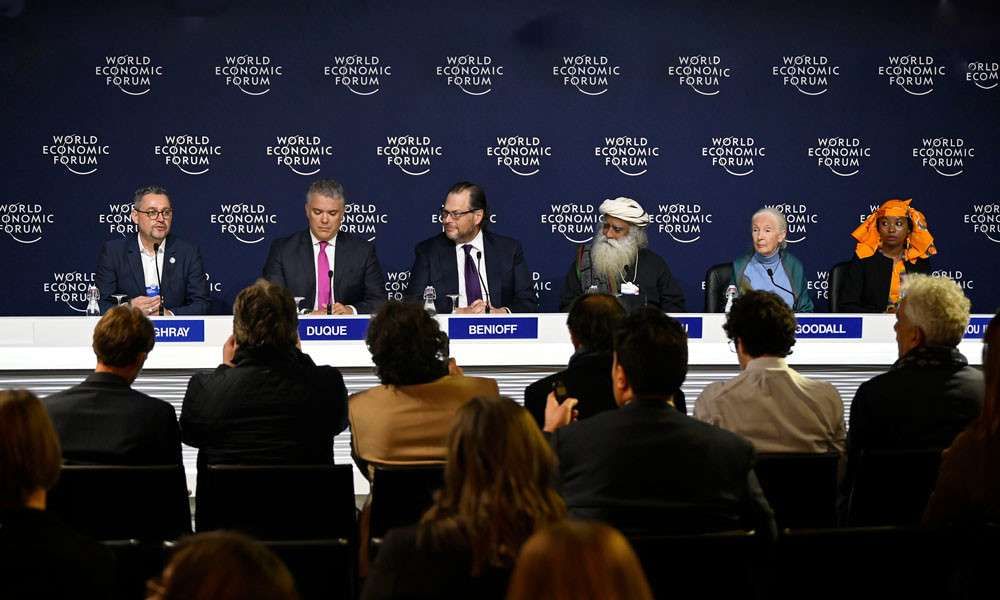Sadhguru at Davos 2020: Towards Creating a Conscious Planet
Sadhguru Champions the One Trillion Trees Platform at the World Economic Forum 2020 in Davos. The major new initiative is led by the United Nations Environment Program (UNEP) and the UN Food and Agriculture Organization (FAO).

Research has shown that a trillion trees could absorb 830 billion tons of carbon dioxide from the atmosphere, which is about two thirds the amount of carbon emitted by humans since the industrial revolution. Taking up the task is the World Economic Forum’s 1T.org
On 20th January, 2020 Sadhguru joined a diverse panel of influential speakers at the World Economic Forum in Davos to support the initiative. Dominic Waughray, the Managing Director of World Economic Forum, personally hosted this panel discussion. He introduced the initiative by explaining that 1T.org exists to serve the global community of initiatives committed to contributing to the goal of growing, restoring and conserving one trillion trees worldwide by 2030, with the aim of bringing the global tree coverage up from 3 trillion trees to 4 trillion trees.
The first speaker was the President of Colombia, Iván Duque Márquez, who said that success in facing climate change is impossible without defeating deforestation. Colombia, having 35% of its territory in the Amazon basin and 50% in tropical jungles, will play a pivotal role. The President has set a laudable goal for Columbia to plant 180 million trees by August 2022. The approach is to plant and generate social consciousness within the community for reforestation, and combating illegal timber trade.
Marc Benioff, the Chairman and Co-Chief Executive Officer of Salesforce (one of the largest tech companies on the planet) explained the crucial role of the private sector in combating climate change by planting trees. He emphasized that the planet, our forests and our environment are key stakeholders for every business. Within 24 hours of launch, between 200 to 300 companies have expressed interest in joining the Trillion Trees Platform and Salesforce has already committed to plant 100 million trees over the next 10 years.
Hindou Oumarou Ibrahim, the President of the Association for Indigenous Women and Peoples of Chad (AFPAT) brought forth the much ignored yet unmistakably essential role that indigenous people must play in this effort. She explained that for indigenous people, a forest is not just a lot of trees, it is a home, food, medicine, knowledge, school, and the very identity which they are losing because of climate change. Underscoring the importance of including indigenous people as partners and stakeholders who can restore the forest, she added, “For them, it is not just about planting trees, it is their life.”
Subscribe
The next speaker was Dr. Jane Goodall, who is one of the world's foremost expert on chimpanzees, and is best known for her over 55-year study of social and family interactions of wild chimpanzees. The Jane Goodall Institute protects chimpanzees and inspires communities across the world to take action for people, animals and the environment. She spoke with a deep passion about how the institute is enabling high school students in 60 countries to plant about 5 million trees globally each year. Her passion for environment and wildlife protection was infectious and the 85-year-old pioneer impressed everyone present, including Sadhguru, who visibly shared a great rapport with her.
Dominic Waughray then introduced Sadhguru, “Such a large movement will require unprecedented mobilization, collaboration and empowerment of people from all parts of the globe. This is where Sadhguru comes in to share his wisdom on how he has been able to establish mass movements for Rally for Rivers and now Cauvery Calling across Southern India.”
Sadhguru explained how people had no connection with trees anymore, and how “tree” has been reduced to just a word in people’s minds. Sadhguru shared how he set up a certain process where people could experience their exhalation as the tree’s inhalation and the tree’s exhalation as their inhalation. Once they felt this, “you cannot stop them from planting trees,” he explained, “Because one half of your breathing apparatus is hanging out there on the tree.” He pointed out the necessity of this connect because it will take 15-20 years to get a tree to a reasonable size, but it can be cut and taken away in one afternoon.
He pointed out that because timber is so lucrative, it is very important that it becomes an economic process for the people. In Southern India, Cauvery Calling is empowering farmers to grow timber trees (as well as other crops) on their land as part of agroforestry. Tree cultivation with crops ensures that the crops yield more and have higher nutritional values. Additionally, the soil recovers, the water tables come up and above all there is a long term crop on the land which helps mitigate rural to urban migration.
It is also very important that this is done on agricultural land, as the rate of survival of a tree is over 90% when the individual farmer is taking care of it because there is an economic incentive for him. Sadhguru reinforced the harsh truth that if we do not marry economy and ecology, economy will win hands down.
In closing, Sadhguru discussed how Cauvery Calling has committed to enabling 5.2 million farmers to plant 2.42 billion trees in one river basin, sequestering about 9-12 trillion litres of water. Pointing out that in collaboration with the 1 Trillion Trees platform, this could be done in various river basins to revive rivers in India and scale this up to 50 billion trees across the country, all on private land. Imagine what could be achieved if this could be further scaled up to rivers across the tropical world!
Editor’s Note: Click here to watch the full panel discussion.
Featured image by WEF




